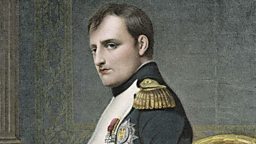Ten Things You Need to Know About War And Peace

1. Why it's SO long
The length of War and Peace is partly explained by the length of time Tolstoy spent planning, writing and polishing it. The earliest draft storylines found in Tolstoy’s manuscripts date back to 1856. The first part of the novel was serialised in the journal The Russian Herald in 1865, and the first edition of the complete novel published in 1868. During this time, Tolstoy’s wife Sofia was an essential helper. The only person who could decipher Tolstoy’s handwriting or deal with his practice of writing not only across the page but vertically in the margins, Sofia copied out at least seven drafts of the novel. Some acquaintances report that she complained of copying it up to twenty-one times! Sofia preserved every scrap of manuscript of Tolstoy’s work, so that after his death, those relating to War and Peace filled twelve wooden crates.
2. Stalin used War and Peace as a propaganda tool during WWII
Russia’s victory over Napoleon in 1812 speaks so strongly to the Russian national psyche that when Hitler attacked the Soviet Union in 1941, Stalin swiftly reached for Tolstoy’s works as a means of promoting a patriotic defence of the motherland. Reprints of the 1812 passages of War and Peace were mass produced, and some sections were even posted on billboards in Moscow for public consumption. This led to the fact that during the Great Patriotic War, as the Russians call WWII, Tolstoy was the most published author in the country, exceeding even Lenin.
3. Why it was thought to be War and World not War and Peace
In modern Russian, the words for ‘peace’ and ‘world’ are identical, a fact which has led to an urban myth that Tolstoy intended his novel to be called War and World. The Cyrillic alphabet was modernised after the 1917 Revolution; prior to this, the words for ‘peace’ and ‘world’, though pronounced the same, were spelt differently. The first time Tolstoy wrote down the title in his drafts, he accidentally used the spelling for ‘world’. However, there is nothing to suggest that this was anything more than a slip of the pen.
4. It wasn’t all written in Russian
In Imperial Russia, French had become the preferred language of the aristocracy, who had adopted European customs and manners following reforms introduced by Peter the Great and Catherine the Great. Following the French Revolution, however, French language and culture began to be less fashionable in Russia. In War and Peace Tolstoy tends to show characters speaking French when he wants to indicate their loss of touch with authentic Russian values. Many readers at the time of publication disliked the dialogues in French, and these were translated into Russian in the novel’s third edition of 1873. However, in the fifth edition of 1886 edited by Tolstoy’s wife, the French passages were restored.
5. Natasha is based on Tolstoy’s sister-in-law
Tatyana Behrs, the younger sister of Tolstoy’s wife Sofia, was a regular visitor to the Tolstoys’ family home at Yasnaya Polyana. Sofia found it hard to adapt to the isolated and somewhat austere life on the country estate, and Tatyana’s presence brought a welcome injection of joy, vivacity and girlish giggles. Tolstoy himself had always had a great fondness for little Tatyana. Her liveliness and spontaneity offered the inspiration for the character of Natasha Rostov. Many episodes of the novel, such as the young Natasha asking Boris to kiss her doll, or Natasha’s despair after being abandoned by Anatole, are taken from real incidents in Tatyana’s life.
6. War and Peace makes a stand against the death penalty
In 1857, Tolstoy witnessed a guillotining in Paris. The event left a profound impression on him and convinced him of the moral wrongness of the death penalty. His views strengthened when some years later, he was asked (as a landowner with local government responsibilities) to defend a soldier facing the death penalty at court martial, and he lost the case. Tolstoy expresses his feelings through the character of Pierre Bezukhov, who notes with horror the anxiety of those French soldiers called upon to execute Russian prisoners of war.
7. Pierre Bezukhov means ‘Peter the Earless’
Many of the surnames of the fictional characters are names of prominent Russian aristocratic families with one or two letters changed, such as Bolkonsky, from Volkonsky, the family name of Tolstoy’s mother. Tolstoy did not intend by this to suggest similarities between his fictional characters and actual persons, but instead meant to create a world familiar and authentic for Russian readers. Bezukhov, on the other hand, is one of the few invented surnames in the novel. ‘Earless’ is a fitting designation for a character whom Tolstoy wanted to show as struggling to listen to the important messages of everyday life.
8. Tolstoy mocks historical sources.
Tolstoy researched the historical context of War and Peace thoroughly, reading both Russian and European historical accounts of Napoleon’s campaigns. He also visited the site of the battle of Borodino (a little over 115km west of Moscow). His aim was less to ensure the accuracy of his historical setting, but more to demonstrate the pitfalls of historical records. This comes across best in an episode in the second half of the novel where Nikolai Rostov’s servant Lavrushka is temporarily captured by the French and interrogated in front of Napoleon. Tolstoy quotes a version of the story from the French historian Thiers, and then ironically offers his own, comical version, where the wily Lavrushka playacts the simple Cossack, as ‘what really happened.’ His message is that his fictional account is just as probable as that of the historian.
9. It’s not just a novel…
Tolstoy’s pre-occupation with the problems of historical record led him to digress from the story of the fictional characters into chapters where he debated the meaning of history as a discipline and how it shapes our understanding of human civilisation. The second part of the novel’s epilogue is entirely devoted to such writing. From the first publication to this day, opinion is divided on the interest and relevance of these historical essays. The French novelist Flaubert complained to the Russian writer Turgenev, “He repeats himself! He philosophizes!” As with the passages in French, the mixed reception of the historical essays led to them being deleted or moved to an appendix in the third edition. However, they were restored in the fifth edition edited by Tolstoy’s wife Sofia.
10. It’s not even a novel…
Tolstoy himself found that the inclusion of his historical essays made it hard to categorize his work as a novel. To accompany the publication of the complete text of the book in 1868, he wrote an explanatory note entitled ‘A Few Words on War and Peace’ in which he mused, “What is War and Peace? It is not a novel, even less is it a poem, and still less an historical chronicle. War and Peace is what the author wished and was able to express in the form in which it is expressed.” In the same essay he dealt with queries and complaints from readers regarding the passages in French, the deviations from historical accuracy, and the relation between real people and fictional characters with similar names.
Authored by Dr Sarah Hudspith, Associate Professor at The University of Leeds



